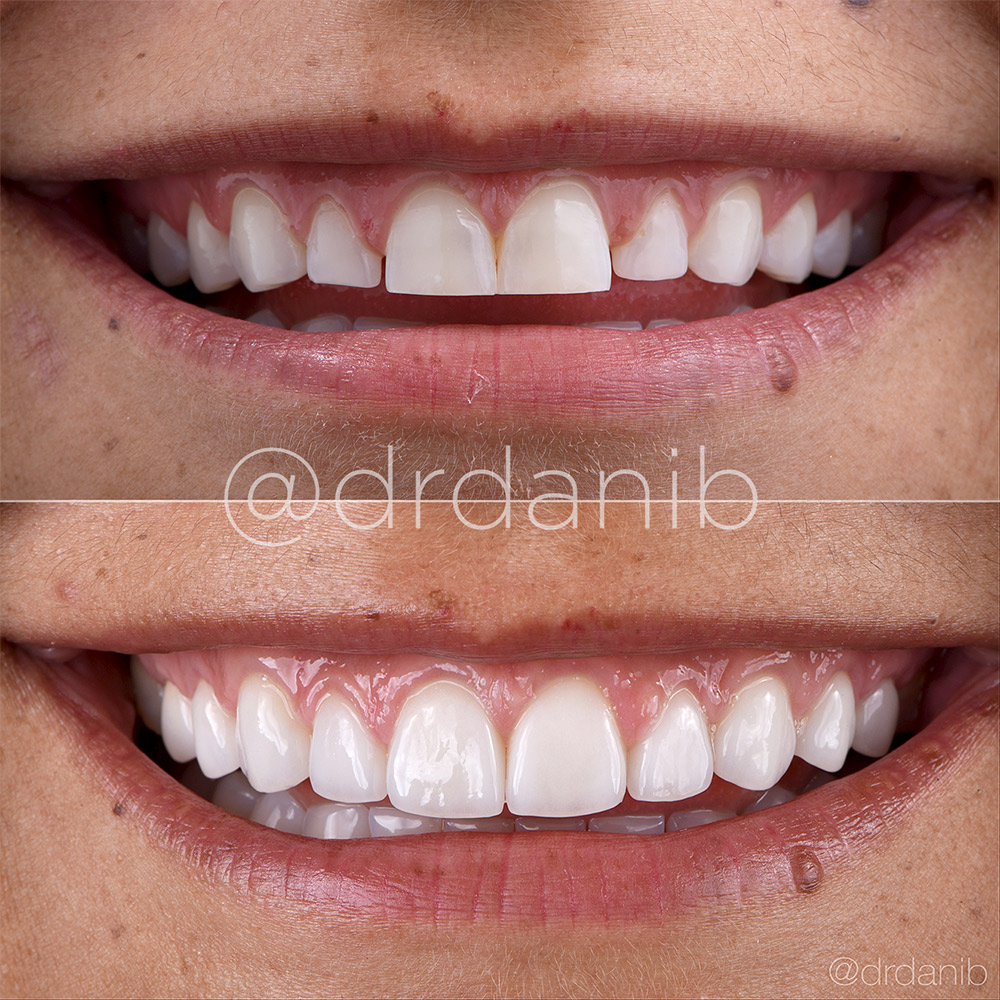The Full Introduction of Veneers: Types, Uses, and Their Effect on Your Smile
Veneers offer as a prominent remedy for individuals looking for to enhance their dental aesthetics. These custom-crafted coverings can effectively mask imperfections such as staining and gaps. With 2 primary kinds available, porcelain and composite resin, each offers distinctive advantages and limitations. The effect of veneers prolongs past simple look, affecting self-esteem and social communications. Comprehending their advantages and types is vital. What might this indicate for one's total lifestyle?
Recognizing Veneers: What They Are and Exactly how They Work
Veneers are thin coverings, usually made from porcelain or composite resin, that are custom-crafted to fit over the front surface of teeth. They serve both aesthetic and practical objectives, providing a solution for various oral flaws such as staining, gaps, and small misalignments. By sticking to the tooth enamel, veneers produce an all-natural look while boosting the form and color of the teeth.
The process typically includes a first examination, where a dental expert examines the patient's needs and reviews wanted results - Dental Veneers. Following this, a marginal amount of enamel may be eliminated to fit the veneer. Impacts of the teeth are then taken to ensure a precise fit. When produced, the veneers are bound firmly to the teeth making use of an unique dental adhesive. This procedure not only improves the smile's look but also aids secure the underlying teeth from additional damages, making veneers a preferred choice for lots of seeking a smile makeover
Types of Veneers: Porcelain vs. Compound Material
The difference between porcelain and composite resin veneers depends on their product structure and attributes. Each type uses varying degrees of sturdiness, cost, and longevity, affecting people' selections based on their individual requirements. Recognizing these differences is crucial for making a notified decision regarding oral enhancements.
Material Distinctions Clarified
While both porcelain and composite resin veneers offer the very same cosmetic objective, they differ greatly in product residential or commercial properties, longevity, and visual outcomes. Porcelain veneers are crafted from a ceramic product that imitates the natural translucence of teeth, providing a natural look. Their smooth surface is immune to staining, making them an attractive option for those looking for a durable visual. In comparison, composite material veneers are made from a tooth-colored plastic product, offering adaptability and convenience of application. They may not accomplish the very same degree of illumination or translucency as porcelain. Furthermore, composite veneers can be extra easily formed and fixed, making them an extra flexible alternative in certain dental situations. Each type offers special benefits tailored to individual choices.
Longevity and Longevity
When comparing porcelain and composite material veneers, durability and resilience are substantial aspects. Porcelain veneers are recognized for their toughness, commonly lasting 10 to 15 years with appropriate treatment. Their resilience against breaking and tarnishing makes them a favored selection for people looking for lasting outcomes. On the other hand, composite material veneers normally have a shorter life expectancy, averaging 5 to 7 years. While they can be fixed a lot more quickly if damaged, they are more at risk to wear and staining gradually. The option between these materials typically depends upon the individual's lifestyle, visual objectives, and maintenance preferences. Eventually, comprehending the differences in longevity and toughness can assist people in picking the veneer kind that best matches their needs.
Price Contrast Insights
Cost is a critical factor to consider when choosing between porcelain and composite material veneers. Porcelain veneers typically range from $800 to $2,500 per tooth, mirroring their resilience, aesthetic charm, and resistance to staining. These veneers require an extra comprehensive treatment and specialized laboratory job, adding to their greater price. In comparison, composite material veneers are usually much more affordable, setting you back between $250 and $1,500 per tooth. They can be applied in a solitary go to, which lowers labor costs. Composite veneers might need extra regular replacements, potentially enhancing long-lasting costs. Inevitably, the selection in between porcelain and composite material veneers relies on individual budget plans and desired end results, balancing preliminary prices against long life and visual outcomes.
The Advantages of Deciding On Veneers for Your Smile
Choosing veneers offers significant advantages for those seeking an improved smile. Their boosted aesthetic charm can transform the appearance of teeth, while their stain-resistant properties assure a long lasting illumination - Dental Veneers. This mix makes veneers a preferred choice for people looking to accomplish a remarkable smile
Enhanced Visual Allure
Veneers typically arise as a favored option due to their transformative visual advantages when people look for to improve their smiles. These slim coverings, usually made from porcelain or composite resin, can properly conceal imperfections such as chips, spaces, and misalignment. By resembling the natural look of teeth, veneers supply a smooth, check over here glowing smile. Their customizable nature enables a customized method, making it possible for individuals to choose shades and forms that best suit their facial features. Furthermore, veneers can develop an uniform appearance, boosting general face balance. This aesthetic improvement not just improves confidence yet can also positively influence individual connections and social communications, making veneers a preferred choice for those looking to achieve a brighter, much more eye-catching smile.
Stain Resistance Advantages
Veneers not only enhance aesthetic allure however likewise provide substantial discolor resistance, making them an appealing choice for people concerned regarding preserving a brilliant smile. Composed of sturdy materials such as porcelain or composite resin, veneers are less permeable than all-natural teeth, which aids protect against the absorption of discolorations from typical perpetrators like coffee, tea, and red wine. This inherent tarnish resistance enables people to enjoy their favored drinks without stressing regarding staining. Dental Veneers. In addition, the smooth surface of veneers makes them less complicated to tidy, further enhancing their longevity and preserving their pristine appearance. As a result, veneers give a practical option for those seeking both beauty and functionality in their oral care
The Process of Obtaining Veneers: What to Anticipate

The process of obtaining veneers might appear intimidating, understanding the steps entailed can reduce issues. An examination with a dentist is needed to figure out if veneers are the ideal solution for the person's oral issues. Throughout this consultation, the dentist will certainly discuss preferred outcomes and take perceptions of the teeth.
Next, a 2nd appointment is set up for tooth prep work, where a percentage of enamel is usually removed to suit the veneers. Short-lived veneers may be positioned while the personalized ones are crafted in a dental lab, which normally takes a number of weeks.
When all set, the dental expert will position the veneers, making sure appropriate fit and color before bonding them to the teeth utilizing a special adhesive. After final modifications, the dental practitioner will provide advice on treatment. Understanding these actions can aid clients feel much more comfortable and educated throughout the veneer process.
Upkeep and Take Care Of Your Veneers
Keeping veneers calls for regular like guarantee their durability and appearance. Proper dental hygiene is crucial; cleaning two times daily with a non-abrasive toothpaste and flossing regularly help avoid plaque buildup around the veneers. Furthermore, routine dental check-ups are essential for keeping track of the condition of the veneers and dealing with any type of prospective concerns beforehand.
Clients ought to avoid difficult foods and extreme force when attacking to stop damages. It's also recommended to limit consumption of discoloring compounds, such as coffee, tea, and red a glass of wine, as these can influence the veneers' color gradually.

Transforming Your Smile: Real-Life Impact of Veneers
A radiant smile can significantly improve one's confidence and overall appearance. For many individuals, veneers work as a transformative solution, efficiently resolving various oral worries such as discoloration, voids, and misalignment. These thin coverings, customized to fit over the front of the teeth, can create an unified and visually pleasing smile.
Real-life cases illustrate the extensive influence veneers can have. Individuals commonly report an immediate increase in self-esteem and social interactions this hyperlink following their treatment. The newfound confidence can lead to more opportunities in personal and professional life, as people really feel more likely to involve and reveal themselves.
Furthermore, the psychological advantages prolong beyond mere appearance; numerous experience enhanced psychological well-being as they embrace their smiles. Consequently, veneers not only improve physical attributes yet additionally add greatly to general lifestyle, emphasizing their value in cosmetic dentistry.
Regularly Asked Questions
The Length Of Time Do Veneers Commonly Last Before Requiring Substitute?
Veneers usually last between 10 to 15 years before needing replacement. Elements such as dental health, dental practices, and the kind of material used can influence their longevity and overall sturdiness. Regular oral examinations are recommended.
Can Veneers Be Gotten Rid Of, and if So, Just how?
Yes, veneers can be eliminated. A dental professional usually utilizes specialized tools to carefully remove them from the teeth, find ensuring minimal damages to the underlying enamel, commonly adhered to by essential adjustments or restorations for optimal aesthetics.
Are Veneers Suitable for Everybody's Oral Condition?

Will Getting Veneers Hurt or Require Anesthesia?
Getting veneers usually includes minimal pain, and numerous individuals receive neighborhood anesthetic to guarantee a pain-free experience. Level of sensitivity might take place briefly later, however the majority of locate the process bearable and are satisfied with the outcomes.
Just How Do Veneers Affect Tooth Level Of Sensitivity After Placement?
Veneers can momentarily enhance tooth level of sensitivity as a result of the removal of enamel and the bonding process. Many individuals experience a decrease in level of sensitivity in time as the teeth readjust to the new veneers.
Veneers are slim coverings, typically made from porcelain or composite material, that are custom-crafted to fit over the front surface area of teeth. Porcelain veneers are crafted from a ceramic product that simulates the natural translucence of teeth, supplying a realistic look. Porcelain veneers usually range from $800 to $2,500 per tooth, reflecting their longevity, visual charm, and resistance to staining. In contrast, composite resin veneers are typically a lot more budget friendly, costing between $250 and $1,500 per tooth. Made up of long lasting products such as porcelain or composite material, veneers are less permeable than all-natural teeth, which aids protect against the absorption of spots from common wrongdoers like coffee, tea, and red white wine.